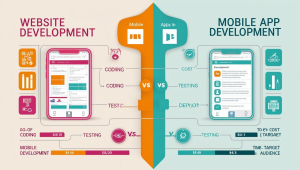Web design vs App development
In today’s digital landscape, South African businesses face a crucial decision: should they invest in web design, app development, or both? Understanding the key differences between these two approaches is essential for making the right choice.
Web Design: Your Digital Front Door
Web design centers on creating and optimizing your website. Think of your website as your digital storefront; it’s often the first impression potential customers have of your business. A well-designed website offers several advantages:
- Accessibility: Anyone with an internet connection can access it through a browser on any device, whether desktop, tablet, or phone.
- Cost-Effectiveness: Generally, developing and maintaining a website is less expensive than building a native app.
- Ease of Updates: You can implement content and design changes quickly and effortlessly.
Web design is ideal for businesses that need a broad online presence, content-heavy platforms, e-commerce stores, and those relying on SEO for customer acquisition.
App Development: A Tailored Mobile Experience
On the other hand, app development focuses on creating software applications specifically for mobile devices like smartphones and tablets. Apps provide distinct benefits:
- Enhanced User Experience: Native apps are optimized for specific operating systems (iOS or Android), delivering a smoother, faster, and more intuitive experience.
- Access to Device Features: Apps can leverage device features such as GPS, camera, and push notifications, enabling richer functionality.
- Offline Access: Many apps can function even without an internet connection.
App development suits businesses aiming to build brand loyalty, offer specialized services, create interactive platforms (like games or social media), and cater to repeat customers.
The South African Context
As smartphone penetration rapidly increases across South Africa, adopting mobile-first strategies has become vital. Research shows that designing a complex app Minimum Viable Product (MVP) in South Africa is significantly more cost-effective than similar projects in the US or UK. This cost efficiency arises from several factors, including lower labor costs, a growing pool of skilled developers, and a favorable exchange rate. South Africa’s vibrant tech ecosystem fosters innovation, enabling businesses to leverage local expertise and resources while maintaining high-quality standards. Consequently, companies can allocate their budgets more effectively, focusing on features that enhance user experience without being constrained by high development costs.
The Hybrid Approach: Progressive Web Apps (PWAs)
Progressive Web Apps (PWAs) offer a compelling middle ground. PWAs are websites that look and feel like native apps but run in a browser. They provide many app benefits, such as offline access and push notifications, without requiring users to download them from an app store.
Making the Right Choice
Choosing the best approach depends on your specific business goals, target audience, and budget.
- Start with a Website: If you’re just starting or need a broad online presence, a website is the logical first step.
- Consider an App for Loyal Customers: If you have a dedicated customer base and want to provide a premium mobile experience, an app may be a worthwhile investment.
- Explore PWAs: PWAs can bridge the gap between web and app experiences effectively.
Need Help Deciding?
If you’re unsure which path to take, we’re here to help! At Just Pointblank, we can assess your needs and develop a digital strategy tailored to your business. Contact us today for a consultation!
Read this: Tadalafil: A Comprehensive Guide to Its Uses, Benefits, and Precautions





